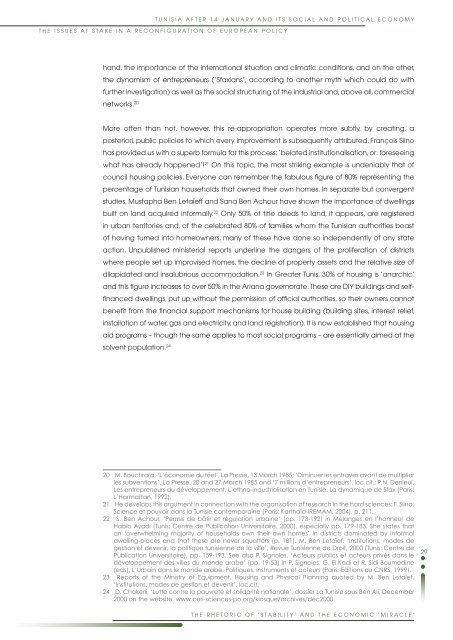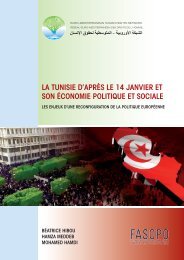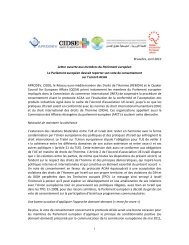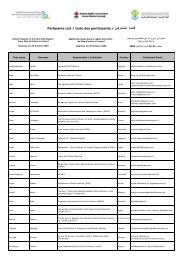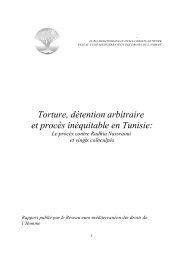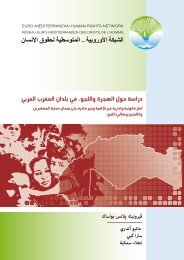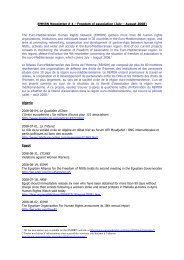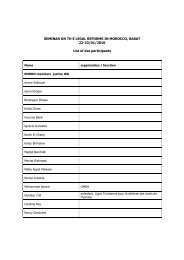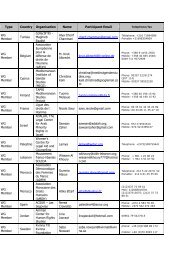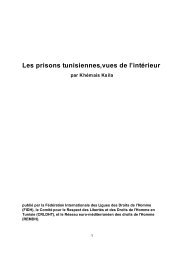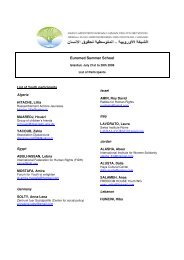tunisia after 14 january and its social and political economy - Refworld
tunisia after 14 january and its social and political economy - Refworld
tunisia after 14 january and its social and political economy - Refworld
Create successful ePaper yourself
Turn your PDF publications into a flip-book with our unique Google optimized e-Paper software.
T U N I S I A A F T E R 1 4 J A N U A R Y A N D I T S S O C I A L A N D P O L I T I C A L E C O N O M YT H E I S S U E S A T S T A K E I N A R E C O N F I G U R A T I O N O F E U R O P E A N P O L I C Yh<strong>and</strong>, the importance of the international situation <strong>and</strong> climatic conditions, <strong>and</strong> on the other,the dynamism of entrepreneurs (‘Sfaxians’, according to another myth which could do withfurther investigation) as well as the <strong>social</strong> structuring of the industrial <strong>and</strong>, above all, commercialnetworks. 20More often than not, however, this re-appropriation operates more subtly, by creating, aposteriori, public policies to which every improvement is subsequently attributed. François Siinohas provided us with a superb formula for this process: ‘belated institutionalisation, or: foreseeingwhat has already happened’! 21 On this topic, the most striking example is undeniably that ofcouncil housing policies. Everyone can remember the fabulous figure of 80% representing thepercentage of Tunisian households that owned their own homes. In separate but convergentstudies, Mustapha Ben Letaïeff <strong>and</strong> Sana Ben Achour have shown the importance of dwellingsbuilt on l<strong>and</strong> acquired informally. 22 Only 50% of title deeds to l<strong>and</strong>, it appears, are registeredin urban territories <strong>and</strong>, of the celebrated 80% of families whom the Tunisian authorities boastof having turned into homeowners, many of these have done so independently of any stateaction. Unpublished ministerial reports underline the dangers of the proliferation of districtswhere people set up improvised homes, the decline of property assets <strong>and</strong> the relative size ofdilapidated <strong>and</strong> insalubrious accommodation. 23 In Greater Tunis, 30% of housing is ‘anarchic’<strong>and</strong> this figure increases to over 50% in the Ariana governorate. These are DIY buildings <strong>and</strong> selffinanceddwellings, put up without the permission of official authorities, so their owners cannotbenefit from the financial support mechanisms for house building (building sites, interest relief,installation of water, gas <strong>and</strong> electricity, <strong>and</strong> l<strong>and</strong> registration). It is now established that housingaid programs – though the same applies to most <strong>social</strong> programs – are essentially aimed at thesolvent population. 2420 M. Bouchrara, ‘L’économie du réel’, La Presse, 13 March 1985; ‘Diminuer les entraves avant de multiplierles subventions’, La Presse, 20 <strong>and</strong> 27 March 1985 <strong>and</strong> ‘7 millions d’entrepreneurs’, loc.cit.; P.N. Denieul,Les entrepreneurs du développement. L’ethno-industrialisation en Tunisie. La dynamique de Sfax (Paris:L’Harmattan, 1992).21 He develops this argument in connection with the organisation of research in the hard sciences: F. Siino,Science et pouvoir dans la Tunisie contemporaine (Paris: Karthala-IREMAM, 2004), p. 211.22 S. Ben Achour, ‘Permis de bâtir et régulation urbaine’ (pp. 173-192) in Mélanges en l’honneur deHabib Ayadi (Tunis: Centre de Publication Universitaire, 2000), especially pp. 179-183. She states thatan ‘overwhelming majority of households own their own homes’ in districts dominated by informaldwelling-places <strong>and</strong> that these are never squatters (p. 181). M. Ben Letaïef, ‘Institutions, modes degestion et devenir: la politique tunisienne de la ville’, Revue Tunisienne de Droit, 2000 (Tunis: Centre dePublication Universitaire), pp. 159-193. See also P. Signoles, ‘Acteurs publics et acteurs privés dans ledéveloppement des villes du monde arabe’ (pp. 19-53) in P. Signoles, G. El Kadi et R. Sidi Boumedine(eds), L’Urbain dans le monde arabe. Politiques, instruments et acteurs (Paris: Editions du CNRS, 1999).23 Reports of the Ministry of Equipment, Housing <strong>and</strong> Physical Planning quoted by M. Ben Letaïef,‘Institutions, modes de gestion et devenir’, loc.cit.24 D. Chakerli, ‘Lutte contre la pauvreté et solidarité nationale’, dossier La Tunisie sous Ben Ali, December2000 on the website www.ceri-sciences-po.org/kiosque/archives/déc2000.29T h e r h e t o r i c o f ‘ s t a b i l i t y ’ a n d t h e e c o n o m i c ‘ m i r a c l e ’


